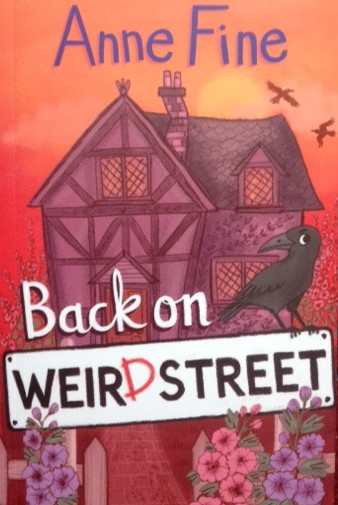Inspiring Young Readers
 posted on 28 Jun 2018
posted on 28 Jun 2018
Back On Weir(d) Street by Anne Fine
This is Anne Fine’s second trip to Weir(d) Street and, as you might guess from the title, it’s another spooky outing that will captivate readers of 8 and over. I’m a great fan of the portmanteau story structure, where a series of short stories are grouped together inside a single framework, and that’s what we’ve got here.
Asim, Laila and Tom like to sit on a wall on their street and tell each other scary tales. It helps that they live on Weir Street because they can change the name to Weir(d) Street and build their tales around the local houses and landmarks – it’s always great to spin yarns about your own neighbourhood.
“The real name of our road is Weir Street. It’s called that because there is a stretch of river at the end that plunges down, fast and deep like a waterfall, over the old weir. But so many strange things happen between the weir and the other end of the road that we three have begun to call it Weird Street.”
On this occasion each of them tells a tale to chill the blood of their friends and Leila kicks off with ‘The Voice From Barton’s Bridge’ as told to her by her friend, Harper. It’s the story of a ghostly voice that she hears in the middle of the night and which tells her to “Look under Barton’s Bridge” . Despite asking for more detail the voice will say nothing more. Several times Harper goes to look under the bridge but she can't find anything odd or unusual. She is, however, watched by a rather grumpy farm worker who seems to be always there when she goes and eventually it's a conversation with him that triggers an idea in her mind that leads her to buried treasure.
Asim’s story is ‘The Strange Tale of Number 17’ that promises to be so scary that Laila can’t even bear to listen and has to put her fingers in her ears. Why does Number 17 Weir Street keep getting new tenants? Why do people move out only days after moving in and sometimes don’t even get as far as moving in? What’s it got to do with the deaf and dumb boy who went missing in 1902? All good questions and you’ll only find the answers if you read the book. My lips are sealed.
Finally, Tom tells them the story of when he went to play with the children in the big, old ramshackle house and witnessed the ghostly apparition that was ‘The Boy In The Greenhouse’. Is it possible that, just for a short time, you could play games with a ghost? See what you think.
Illustrated throughout with lovely, simple textured black and white drawings from Vicki Gausden, the mix of thrills and the comfort of familiarity will appeal to exactly the sort of reluctant readers Barrington Stoke target their ‘super readable’ series to. I’m sure there’s more to come from Weir(d) Street and so look forward to the next instalment.
Terry Potter
June 2018